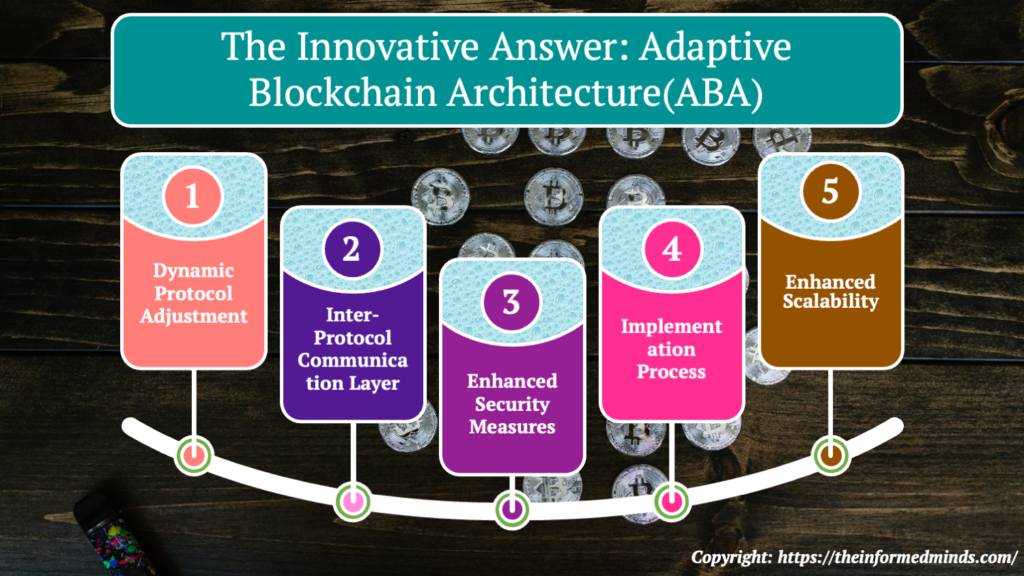To Share is to Show You Care!
In the ever-evolving landscape of blockchain technology, one persistent challenge has been the lack of backward compatibility. As the industry continues to mature, developers and stakeholders grapple with the repercussions of incompatible upgrades, hindering seamless transitions and limiting the overall progress of blockchain networks. In this blog post, we’ll explore the root causes of this issue and present a groundbreaking solution that promises to revolutionize backward compatibility in blockchain.
1. Understanding the Challenge
1.1 Rapid Evolution of Blockchain Protocols

The fast-paced evolution of blockchain protocols often results in a lack of standardized practices, making it difficult for new updates to seamlessly integrate with existing systems.
1.2 Divergent Development Paths
Different blockchain projects often take divergent development paths, leading to incompatible changes that disrupt the interoperability of smart contracts and decentralized applications (DApps).

1.3 Security Concerns

Implementing backward compatibility without compromising security is a delicate balance. Ensuring that older versions remain secure while accommodating new features is a formidable challenge.
2. The Revolutionary Solution: Adaptive Blockchain Architecture (ABA)
Introducing the Adaptive Blockchain Architecture (ABA), a groundbreaking approach designed to address the lack of backward compatibility in blockchain systems.

2.1 Dynamic Protocol Adjustment
Dynamic Protocol Adjustment is a foundational feature of ABA that facilitates a flexible and gradual approach to protocol upgrades. Unlike traditional hard forks, where all nodes must upgrade simultaneously, ABA allows nodes to adjust to new protocol versions at their own pace.
How it Works
- ABA enables a seamless transition by allowing nodes to update gradually without the need for a synchronized hard fork.
- Nodes can continue operating on the old protocol until they are ready to switch to the new version, minimizing disruptions to the network.
Benefits
- Smooth Transition: ABA ensures a smooth transition to new protocol versions, preventing sudden disruptions in blockchain operations.
- Reduced Downtime: The dynamic adjustment minimizes network downtime, ensuring uninterrupted blockchain functionality during the upgrade process.
2.2 Inter-Protocol Communication Layer
The Inter-Protocol Communication Layer is designed to address the challenge of divergent development paths taken by different blockchain projects. It acts as a bridge, enabling communication and interaction between various blockchain protocols.
How it Works
- The layer facilitates seamless communication between different versions of the blockchain, allowing them to exchange data and transactions.
- Smart contracts and decentralized applications (DApps) can operate across different protocol versions, promoting interoperability.
Benefits
- Unified Ecosystem: ABA promotes a cohesive and interconnected blockchain environment by enabling communication between different protocol versions.
- Cross-Project Compatibility: Smart contracts and DApps developed on one blockchain can interact with those on another, enhancing compatibility across diverse blockchain projects.
2.3 Enhanced Security Measures
Maintaining robust security is a critical concern in blockchain systems. ABA prioritizes security by implementing advanced measures to ensure the integrity and safety of smart contract execution across different protocol versions.
How it Works
- ABA incorporates sophisticated security protocols to safeguard the blockchain network from vulnerabilities associated with backward compatibility.
- The security measures implemented in ABA aim to prevent potential risks and vulnerabilities that may arise during the coexistence of different protocol versions.
Benefits
- Secure Transactions: Users can transact with confidence, knowing that ABA has implemented measures to uphold the security of the blockchain network.
- Minimized Security Risks: By addressing security concerns associated with backward compatibility, ABA enhances the overall resilience and security of the blockchain system.
2.4 Implementation Process
The Implementation Process of ABA outlines the practical steps and strategies for deploying the adaptive blockchain architecture, ensuring a smooth and collaborative transition.
Key Components
- Gradual Protocol Upgrades: ABA allows for gradual protocol upgrades, minimizing the need for sudden and disruptive hard forks.
- Community Consensus Mechanism: ABA incorporates a community-driven consensus mechanism for decision-making, ensuring active participation from stakeholders.
- Developer-Friendly Tools: ABA provides user-friendly tools for developers to test and deploy backward-compatible smart contracts, streamlining the development process.
Benefits
- Smooth Deployment: The gradual protocol upgrades and community consensus mechanisms contribute to a smoother deployment process.
- Community Involvement: Stakeholders actively participate in decision-making, fostering a collaborative and inclusive approach to backward compatibility.
- Developer Adoption: User-friendly tools encourage developers to adopt ABA, promoting widespread implementation across various blockchain projects.
2.5 Enhanced Scalability
Scalability is a paramount concern in blockchain networks, and ABA addresses this by introducing enhanced scalability features. The architecture optimizes the efficiency of data processing and transaction validation, ensuring that the network can handle increased transaction volumes without compromising performance.
How it Works
- ABA incorporates innovative approaches to optimize block size, transaction throughput, and consensus mechanisms, resulting in improved scalability.
- The enhanced scalability of ABA positions blockchain networks for broader adoption, accommodating the growing demands of decentralized applications and user interactions.
Benefits
- Improved Throughput: ABA’s focus on scalability translates to improved transaction throughput, fostering a more responsive and efficient blockchain network.
- Facilitates Mass Adoption: By enhancing scalability, ABA contributes to creating a blockchain ecosystem that can handle a larger user base and a multitude of applications, paving the way for mass adoption.
Conclusion
The lack of backward compatibility in blockchain has been a persistent challenge, hindering the industry’s progress. However, with the introduction of the Adaptive Blockchain Architecture (ABA), a new era of seamless interoperability is on the horizon. By dynamically adjusting protocols, facilitating inter-protocol communication, and prioritizing enhanced security measures, ABA promises to revolutionize how blockchain networks evolve and interact.
Embrace the future of blockchain technology with ABA, where compatibility meets innovation, and the possibilities are limitless. Stay ahead in the rapidly evolving blockchain landscape by adopting the solution that bridges the gap and unifies blockchain ecosystems for sustained growth and success.
Frequently Asked Questions
1. What is backward compatibility in blockchain?
Answer: Backward compatibility in blockchain refers to the ability of a new version or upgrade of the blockchain protocol to seamlessly interact with and support the data and transactions of the previous version. It ensures that existing applications, smart contracts, and nodes remain functional and compatible with the upgraded blockchain.
2. What is the problem with backward compatibility?
Answer: The problem with backward compatibility arises when changes or upgrades to the blockchain protocol are not designed to maintain compatibility with the previous version. This can lead to disruptions in the network, rendering existing applications and smart contracts incompatible and potentially causing a split in the blockchain.
3. Why is backward compatibility necessary?
Answer: Backward compatibility is necessary to ensure a smooth and uninterrupted transition when upgrading blockchain protocols. It allows existing nodes and applications to coexist with the upgraded version, preventing disruptions, maintaining the integrity of the network, and facilitating a seamless user experience.
4. What is backward compatible in a network?
Answer: Being backward compatible in a network means that a newer version of the network or protocol is designed to work seamlessly with the data and functionalities of the previous version. This ensures that devices, applications, and nodes running older versions can still communicate and operate effectively within the network.
5. What is the term for a blockchain upgrade that is not backward compatible?
Answer: A blockchain upgrade that is not backward compatible is often referred to as a hard fork. In a hard fork, the changes made to the protocol are significant enough to create a divergence from the previous version, resulting in a split in the blockchain and making the new version incompatible with the old one.
6. What is an example of backward compatibility?
Answer: An example of backward compatibility is when a blockchain protocol introduces a new feature or improvement without breaking the existing functionality. All previously deployed smart contracts and applications continue to operate smoothly on the upgraded blockchain, ensuring a seamless transition for users.
7. Why is compatibility a problem?
Answer: Compatibility becomes a problem when changes or updates to a system, such as a blockchain protocol, are not carefully managed to ensure backward compatibility. This can lead to fragmentation, disruptions, and incompatibilities between different versions, causing challenges for developers, users, and the overall network stability.
8. What is the difference between forward and backward compatibility?
Answer: Forward compatibility refers to the ability of a system to accept future updates or versions without disruption, while backward compatibility ensures that a new version can work seamlessly with the existing one. Forward compatibility looks ahead to future updates, while backward compatibility looks back to maintain interoperability with the past.
9. What is the opposite of backward compatibility?
Answer: The opposite of backward compatibility is forward incompatibility or simply incompatibility. Forward incompatibility occurs when a new version of a system or protocol is unable to operate with or support the existing version, creating a barrier to smooth transitions and updates.
10. How do you ensure backward compatibility of an API?
Answer: Ensuring backward compatibility of an API involves careful planning and testing. Developers need to avoid making breaking changes to existing endpoints, maintain consistent data formats, and provide fallback mechanisms for deprecated features. Rigorous testing and versioning practices also play a crucial role in ensuring a smooth transition for API users.
11. What is backward compatibility in API?
Answer: Backward compatibility in API (Application Programming Interface) ensures that changes or updates to the API do not disrupt the functionality of existing client applications. It allows older versions of the API to coexist with newer ones, enabling a gradual transition for developers and minimizing the risk of service interruptions.
12. What is the backward compatibility strategy?
Answer: The backward compatibility strategy involves implementing practices and processes to ensure that changes or upgrades to a system, such as a blockchain or API, do not break compatibility with the existing version. This may include versioning, maintaining consistent interfaces, and providing clear documentation to guide users through the transition to newer versions.
The Informed Minds
I'm Vijay Kumar, a consultant with 20+ years of experience specializing in Home, Lifestyle, and Technology. From DIY and Home Improvement to Interior Design and Personal Finance, I've worked with diverse clients, offering tailored solutions to their needs. Through this blog, I share my expertise, providing valuable insights and practical advice for free. Together, let's make our homes better and embrace the latest in lifestyle and technology for a brighter future.

